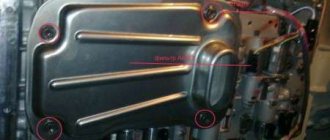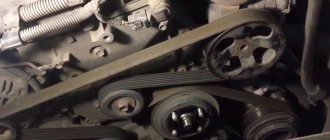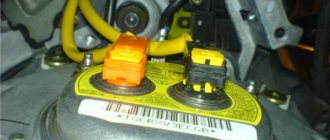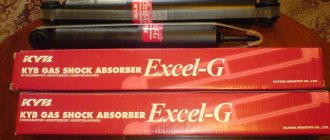Power steering Toyota Prado 120, like other components of the car, is reliable, but requires periodic maintenance, and only by paying timely attention to the power steering, your trips will be without discomfort and financial costs. One of the reasons that “hints” at replacing the fluid in a Toyota Prado is a heavy steering wheel and power steering noise. It hums most often when it is cold, but after the engine warms up the sound stops. If the problem is ignored, the power steering will not stop humming, and the sound will become increasingly stronger and unpleasant. In the worst case, which in principle happens most often, the power steering pump fails; in the best case, it is necessary to completely replace the fluid and wash the filter mesh in the power steering fluid reservoir.
In any case, timely replacement of power steering fluid in a Toyota Prado 120 will cost less than purchasing and replacing a power steering pump.
When to change
The power steering fluid must be completely changed at 40,000 km, or at least once every 2 years. But, just as in the case of the engine, it is recommended to periodically inspect the condition of the fluid - every 10,000 km, and focus on its condition.
The smell of burning or melted rubber, dark brown or even black color indicate that it is time to change the fluid.
Of course, this does not mean that after 60,000 km without replacement there will be problems! In practice, with an adequate style of car operation, problems with power steering do not arise on new cars even after 150,000 km. But let's remember the importance of changing engine oil in reliable Toyota engines and transmissions! In the steering, parts are also subject to friction and subsequent rapid wear due to poor quality lubrication.
Definitely, it’s up to you to decide which interval for changing the power steering fluid to choose for your Prado 120. But if problems arise with control and expensive consequences, especially inappropriate when traveling long distances, I think you should think about changing the oil, besides, the procedure is not complicated, but the fluid quite cheap with a mileage of 40,000 km for a car of this rank.
How much to fill (filling volumes)
Filling volumes for Prado 120
- Fuel tank for diesel/petrol – 87 l (fuel euro diesel and AI 92 and higher)
- Engine lubrication system 2TR-FE 2.7/1GR-FE 4.0/5L-E 3.0/1KZ-TE 3.0 – 5.8 l/5.2 l/6.9 l/7.0 l. API 10W30 and 5W30 for gasoline SJ/SL and for diesel G-DLD-1, API CF-4/API CF.
- Cooling system for engines 2TR-FE 2.7/1GR-FE 4.0/5L-E 3.0/1KZ-TE 3.0 – 8.3 l/9.4 l/9.3 l/12.4 l.
- Oil for manual transmission 5-speed/6-speed – 2.2 l/1.8 l. Transmission oil GL-4, GL-5 with viscosity 75W90 is used.
- Automatic transmission 4-speed/5-speed – 2.0 l/3.0 l. Toyota Genuine ATF Type T-IV.
- Power steering – 1.5 l. DEXRON II or III is used.
- Brake fluid – 1.6 l. SAE J1703 or FMVSS No.116 DOT 3.
- The windshield washer reservoir holds 4.3 liters.
Filling volumes for Prado 150
- Cars with additional fuel tanks hold 150 liters of fuel, without additional tanks 87 liters. This applies to both gasoline and diesel cars.
- The lubrication system will require 1GR-FE/2TR-FE/1KD-FTV - 6.1 l/5.7 l/7.0 l for each engine. For 1GR-FE and 2TR-FE, viscosities 0W-20, 5W-30 and 10W-30 are suitable. For 1KD-FTV, synthetic motor oils with a viscosity of 5W-30, 5W-40, 10W-40 with API CF-4, CD, CE, ACEA B1 approval are suitable.
- Cooling system for engines 1GR-FE/2TR-FE/1KD-FTV – 12.8 l./9.9 l./14.9 l.
- Automatic transmission 1GR-FE/2TR-FE/1KD-FTV – 10.9 l./9.9 l./10.6 l.
- Manual transmission 5 speed/6 speed – 2.2 l./2.1 l. 75W-90.
Spread the love
What kind of liquid to fill
In the case of power steering oil for Prado 120, the choice is simpler. It is necessary to pour what is written on the filler cap of the power steering fluid reservoir (POWER STEERING FLUID). Original power steering fluid:
- Toyota ATF Dexron III (08886-80506);
- Toyota PSF (08886-01005), 4 liter canister;
- Toyota PSF NEW-W (08886-01115), for cold climates;
But using Toyota fluid is not necessary; it is enough to choose a high-quality analogue of Dexron III from another manufacturer, which has positive reviews and a high quality rating. For example:
| Brand | Oil brand |
| Castrol | Transmax Dex III Multivehicle |
| GT-OIL | ATF Type III |
| Idemitsu | ZEPRO PSF (16470005) |
| Petro-Canada | DuraDrive MV Synthetic ATF |
| RAVENOL | Hydraulik PSF Fluid (Toyota PSF-EH approval) |
| Total | Fluide XLD FE |
| Takumi | ATF D-3 |
By the way, some owners, including Toyota LC Prado J120, successfully use the following as power steering fluid: All-season hydraulic oil - VMGZ.
Information on the types of oil required
For the steering of a Toyota Land Cruiser Prado, the manufacturer recommends using original Toyota PSF fluid. Analogs of this oil are the following liquids:
Pentosin CHF 11S
This is a synthetic high-performance multi-purpose hydraulic oil designed to operate a variety of automotive hydraulic drives, including hydraulic power steering, hydropneumatic suspension, shock absorbers, stability control and many other units. This liquid can be used in fairly harsh temperature conditions. Some of the main advantages of Pentosin CHF 11S hydraulic fluid are:
- Versatility of use;
- Increased resistance to low-temperature operating conditions;
- Increased resistance to high temperature operating conditions;
- High resistance to foaming;
- High resistance to oxidative processes;
- Excellent compatibility with sealing joint materials;
- High resistance to metal corrosion;
- Good resistance to heavy loads during operation.
Replacement
The plan of action for self-replacement is simple, but still each owner carries out the replacement procedure differently based on capabilities and the presence or absence of certain tools and devices.
- Warm up the engine, turn off and lift the front of the car;
- Pump out the fluid from the power steering reservoir (using a syringe and a dropper tube, a special apparatus, etc.);
- Remove the clamps and hoses from the power steering. Insert the return hose into the drain container (a 1.5-liter plastic bottle will do just fine);
- Completely remove the empty tank and clean the walls of deposits and the mesh of dirt, then rinse the tank with oil (before removing, place a rag, etc., in case of leakage). If you cannot effectively clean the reservoir with gasoline, kerosene or 646 solvent, use brake cleaner or carburetor cleaner (for example, Hi Gear or Ravenol);
- Place the tank in its original place and connect the supply hose to the system. Plug the return fitting using a syringe needle cap, which is perfect for this. The second hose should be in a container to drain the old fluid;
- Fill the reservoir with new oil and start the engine for 2 seconds. Repeat this procedure 3-4 times until new fluid flows from the hose;
- Carefully pull out the “plug” and connect the return hose. If necessary, add liquid to the middle of the level;
- Start the engine and turn the steering wheel left and right to the extreme positions 4-5 times. Turn off the engine;
- Most likely, the power steering fluid will not yet be clean enough, so once again pump it out of the reservoir with a syringe (device) and add it to the level;
- Start the power unit and turn the steering wheel again. To allow air to escape from the system, hold the steering wheel in its extreme positions for 1-2 seconds;
- After replacing, drive a little and, if necessary, add oil to about;
We also suggest watching a video guide on replacement, perhaps in it you will find a more convenient solution for yourself.
Generation history and engine range
There are 4 generations in the Toyota Prado line. The first generation (J70) started selling in 1990. Toyota Land Cruiser Prado was a lighter version of the Land Cruiser 70. Those cars were equipped with 2.4 and 2.7 liter naturally aspirated injection engines. Diesel versions had a volume of 2.8 liters. There were also turbodiesel engines of 2.3 and 3.0 liters. The first generation was produced for six whole years until 1996.
The second generation (J120) was also produced for six years (from 1996 to 2002). The second generation Toyota Land Cruiser Prado was also equipped with an old 2.7 liter engine and a new 3.4 liter (with V6). In 1999, the appearance was restyled, but in 2000 a new 3.0 turbocharged diesel engine was added.
The third generation (J120) was produced from 2002 to 2009. The engines were the same 2.7 and 3.4 petrol, 3.0 liter turbodiesel. In 2004, there was a big upgrade of engines, where the old ones were replaced by new ones of 2.7 liters and 3.0 liters. The turbodiesel was also replaced with a 4.0 liter.
The fourth generation (J150) began production in 2009. It was made on the updated 120 series platform. In appearance it was more like a previous generation car.
Power steering Toyota tundra | Toyota car
443100C110 44310-0C110 Original power steering pump Toyota Seqouia Tundra
Toyota Tundra steering rack repair. Steering rack repair for Toyota Tundra in St. Petersburg
"GT" Power steering pump bulkhead Toyota Karina E
TOYOTA steering cable, unpacking the package.
strange sound from the generator/power steering
Repair of power steering patrol in the tundra
1763330 Hose assembly for power steering hydraulic pump
Tool for Toyota
4431048070 443100E020 Original power steering pump Lexus RX
043750C041 04375-0C041 Original front driveshaft crosspiece Toyota Seqouia Tundra
Also see:
- Toyota celica t23 operating instructions
- Toyota 4runner jacks
- Oxygen sensor Toyota rav 4
- Toyota Corolla 2009 rim size
- Toyota Corolla Shuttle 2014
- Toyota rav4 2021 parnas
- Auto glass agc Toyota
- Analysis of Toyota Corolla e11
- Top gear Toyota Prius
- Toyota Prado 150 specifications
- Anti-roll bar for Toyota Carina 2
- Toyota manual transmission device
- Toyota Corolla 2008 has trouble starting
- Toyota remote control
- Replacing the fuel filter on a Toyota Corolla spacio
Home » Selections » Power steering Toyota tundra toyota-nims.ru
Articles
The original Camry 40 steering shaft can be found by catalog number 4522033190 . If you plan to install analog parts, products from the following manufacturers are suitable:
Original steering shaft 4522033190 (Link to photo source)
- DOMINANT (catalogue number – TO45022033190);
- NSP (article - NSP044522033190);
- SAT (catalog number – ST4522033190);
- UKORAUTO (UAA4522033);
- ABLTON (article ABL4522033190);
- QUATTRO FRENI (QF01E00033).
If you only change the crosspieces, then according to driver reviews, RU452080TO and Toyo ST1639 performed well.
Crosspiece Toyo ST1639 (Link to photo source)
Signs indicating that the power steering pump or its components need to be replaced
The power steering pump is a fairly reliable element, breakdowns of which rarely occur. If there are signs indicating that something is wrong with it, you need to urgently contact a specialized car service. Otherwise, the power steering system will not work effectively, which will make driving the car unsafe. Moreover, very little time will pass and replacing the power steering pump oil seal or the mechanism itself will not be enough. You will have to change the entire system, and this is a service whose price is quite high.
So, what are the signs that indicate a broken power steering pump?
First of all, you need to pay attention to the noise that appears in the area of the steering rack; Inspect the pump and, if you notice oil leaks on it, immediately contact a car service - leaks must be repaired in a timely manner; Another sign is the need to apply force when turning the steering wheel.
How to change the steering cardan
- It is better to roll the car into a pit (at least raise it in front of the car).
- Fix the steering wheel and steering wheel at a right angle. You should also not move or touch the wheels during repairs.
- Remove the front wheel, then unscrew the mounting bolt through the interior. If all operations are carried out correctly, the shaft should come off the steering wheel on its own.
- Remove both casings (top and bottom), make sure there is a boot on the steering shaft. If it is not there, it is better to install it after repair; the part costs no more than 200 rubles.
- Unscrew the bolt on the crosspiece, then the shaft will come off the steering rack on its own.
- Pull down and pull out the shaft. Before repairing, it is better to wash it from dirt and rust; it also affects the quality of movement.
- Secure the shaft in a vice. When it is secured, take the head and knock out the cross on one side to remove the bearing cup. Repeat the same action from the other end.
- Insert a new cross in the same order (one at a time on each side).
- Press in a new crosspiece with a vice (do not overpress).
- Align the cups and roll them with a hammer and chisel.
- Install the new part on the car in reverse order.
Replacing Camry 40 steering shaft crosspieces
Camry 40 steering shaft crosspieces are located on both sides of the driveshaft. Before removing the unit into the interior, you should put marks. The faulty crosspiece is pressed out for subsequent replacement with a new one. Toyota does not sell the original crosspiece separately, so analogues are installed (proven parts were discussed above).
Installing Camry 40 crosspieces requires taking into account the play of the mounting holes, so the spare part needs to be centered or lightly welded. Reassembly is carried out according to the marks. The cardan returns to its place with replaced crosspieces. If everything is done correctly, characteristic signs of shaft failure will not be observed.
Reasons why the pump or its elements need to be replaced
Modern power steering pumps for Toyota have a long service life and are famous for their reliability and durability. They should be replaced only with original elements that have been certified in our country. By observing the conditions of their operation, you can extend their service life for a long time, and in this case the cost of replacing the power steering pump will be fully justified.
At the same time, you need to know the reasons why this element fails. These include:
- Use of oil of inadequate quality, untimely replacement of it or untimely replacement of the filter, as well as incorrect selection of oil;
- Refusal to use a mixture of power steering oil and engine oil for a long time - only as a temporary solution when a leak is detected;
- Failure of the power steering system. Failure of this element leads to its slipping and the appearance of a whistling sound from under the hood. The power steering pump belt should be replaced as quickly as possible;
- Leaks, penetration of air masses into the power steering system, bending of the channels through which oil flows. In order to accurately determine the cause of the breakdown, diagnostics are carried out;
- Defects in pump components. In order to find out which element has failed (bearing or shaft), diagnostics are carried out. In this case, it happens that repairing the element itself will be too expensive and it is more advisable to replace the entire pump.











